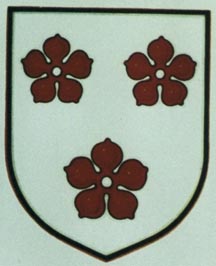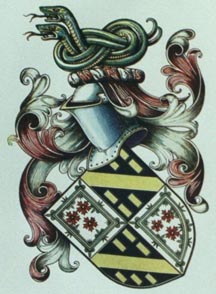 |
 |
|
|
15th century |
12th to 15th Centuries
The founder of the family in Scotland,
Levingus, said to have been of noble Hungarian(1)descent,
settled in West Lothian towards the end of the eleventh century, and Livingston
(the town or residence of Levingus), in Linlithgowshire, long continued
in the possession of the senior line: "Thurstanus filius Levingi" is distinctly
documented in 1128. Gradually we find the knights and barons of Livingston
and Callendar becoming prominent among the Magnates Scotiae, filling the
offices of Great Chamberlain in Scotland, Lord Justice General, Ambassador
to England, Governor and Custodier of the king’s person, and Regent of
the Kingdom; their banner waving in ever battle, and their influence acknowledged
in every council. One is knighted under the Royal Standard, and taken prisoner
at the battle of Durham, 17th of October, 1346 another falls at Homildon,
14th of September, 1402, and Sir Bartholomew de Levingstone, the last of
the elder line, is killed at Flodden, gallantly fighting by the side of
his chivalrous sovereign, on the fatal 9th of September, 1513.(2)
Long before this, the younger branch, that of Callendar, in which the representation
of the main line eventually merged, had risen to great power, by the acquisition
of that ancient Thanedom, partly by royal grant, and partly by a fortunate
or judicious marriage. In 1345/46, Sir William Livingston (grandson of
Dominus Erchebaldus de Levingstone, Miles,(3)
who had been compelled to swear fealty to Edward the First) obtained the
great Thanedom of Kallendar or Calynter, by charter under the great seal,
on the forfeiture of Patrick de Calynter; but, in order to strengthen his
right to these domains, or, it may be, to conciliate the numerous retainers
of the former barons, or, perchance, under the influence of the grace and
beauty, and in sympathy for the fallen fortunes of the young lady, Sir
William married Christine de Calynter, the only child and heiress of the
tainted Thane. By her he had two sons, the younger of whom, William, carried
on the line of the family. Of the ancient Scottish Thanedoms, that of Calentyr,
possessed by the Calentyrs of Calentyr, from a period prior 1217, appears
to have been the only one situated to the south of the Forth; and it was
continued by the marriage of Christine de Calentyr and Sir William Livingston
in the possession of the lineal descendants the original Thanes for the
long period of five hundred years.
 |
 |
|
|
15th century |
Sir Alexander Livingston, the fourth of Callendar, was one of the jury on the trial of Murdoc Duke of Albany (1424); and, at the death of James I., was constituted regent of the kingdom, and guardian of the young monarch, James II. The Chancellor, Chrichton, had, however, custody of the king in the Castle of Edinburgh, and it was only by a ruse that the deliverance of the sovereign was effected. The Queen Dowager (Jane Beaufort), who was a devoted adherent of Livingston’s, contrived to get access to her son, and conveyed him, concealed in a chest, on board a vessel then lying at Leith, which, with its royal freight, immediately set sail, and arrived at Stirling almost as soon as the Chancellor heard of the escape. At Stirling their Majesties were joyfully received by the Regent, but the good understanding between the Queen and Livingston was not of long duration, and in 1439 their animosities had reached to such a height that her Majesty was imprisoned by Livingston’s order. The dissensions, too, between the Regent and the Chancellor continued, till the increasing power and audacity of the young Earl of Douglas, sixth Earl and third Duke of Touraine, the greatest subject in the kingdom, forced them into a temporary reconciliation. Douglas, besides Galloway and Anandale, and other extensive territories in Scotland, possessed the Duchy of Touraine and County of Longueville in France. In right of his Duchy, he regarded himself as a foreign prince, independent of the laws of his country. He was attended by a constant train of one thousand horse, and his household displayed a regal magnificence, while he even created knights, and convened his great vassals in Parliaments. Soon after their reunion, Livingston and Crichton, dissembling their intentions asked the Earl of Douglas to sup at the royal table in the Castle of Edinburgh; the earl was foolhardy enough to accept the invitation, and proceeded to his sovereign’s presence. At first he was received with apparent cordiality, but shortly after he had taken his place at the board, the head of a black bull, the certain omen in those days, in Scotland, of immediate death, was placed upon the table. The earl sprang to his feet and attempted to escape, but being speedily seized and overpowered, he was hurried, along with his younger brother David, and Sir Malcolm Fleming, of Cumbernauld, one of his chief retainers, into the courtyard of the castle, where they were stripped of their armour, and all three in succession beheaded on the same block.(4) The death of the young and princely Earl of Douglas excited universal detestation, and his untimely fate was lamented in the ballads of the time:
| "Edinburgh Castle, Toune, and Toure,
God grant thou sink for sin, And that even for the black dinoure Earl Douglas gat therein." |
Footnotes
(1) Mr. E.B. Livingston wrote: “This Leving or Living, whose name in the contemporary monkish Latin charters is written Levingus, was undoubtedly of Saxon lineage . . ..” See E.B. Livingston, The Livingstons of Callendar, Edinburgh University Press, 1920, pages 1, 3 and 4.
(2) Bartholomew de Livingston was not knighted. He completed his Bachelor of Arts (St.Andrews) in 1499 and his Master of Arts (St. Andrews) in 1501; and was known as Master Bartholomew de Livingston in honour of this achievement. He died (d.s.p.) between June 17 and September 11, 1512; not a year later at Flodden as indicated here. See The Livingstons of Callendar, ut supra, pages 7 and 9.
(3) Sir Erchebaldus (Archibald) de Livingston may have been the ancestor of the Livingstons of Livingston, but there is no evidence to confirm this. Sir William Livingston who married Christian de Callendar was a grandson of Sir Andrew de Livingston who was probably a brother of Sir Archibald. See The Livingstons of Callendar, ut supra, pages 5, 7, 24, 25 and 485.
(4)
The young Earl of Douglas and his brother were executed on November 24,
1440. Sir Malcolm Fleming was executed four days later, the delay
likely being due to objections raised by Sir Alexander Livingston.
See The Livingstons of Callendar, ut supra, pages 43 and
44.
| Please click to:
Go forward to 16th and 17th Centuries Return to Introduction |
and